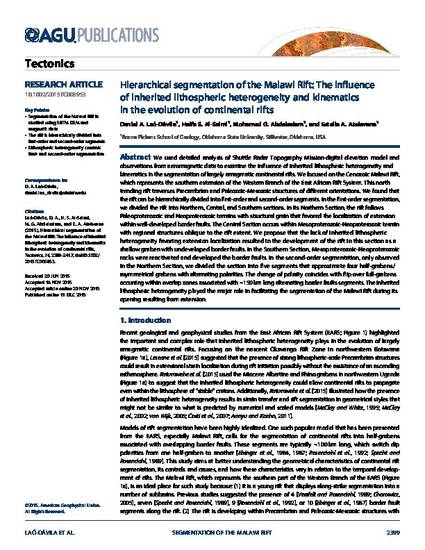
We used detailed analysis of Shuttle Radar Topography Mission-digital elevation model and observations from aeromagnetic data to examine the influence of inherited lithospheric heterogeneity and kinematics in the segmentation of largely amagmatic continental rifts. We focused on the Cenozoic Malawi Rift, which represents the southern extension of the Western Branch of the East African Rift System. This north trending rift traverses Precambrian and Paleozoic-Mesozoic structures of different orientations. We found that the rift can be hierarchically divided into first-order and second-order segments. In the first-order segmentation, we divided the rift into Northern, Central, and Southern sections. In its Northern Section, the rift follows Paleoproterozoic and Neoproterozoic terrains with structural grain that favored the localization of extension within well-developed border faults. The Central Section occurs within Mesoproterozoic-Neoproterozoic terrain with regional structures oblique to the rift extent. We propose that the lack of inherited lithospheric heterogeneity favoring extension localization resulted in the development of the rift in this section as a shallow graben with undeveloped border faults. In the Southern Section, Mesoproterozoic-Neoproterozoic rocks were reactivated and developed the border faults. In the second-order segmentation, only observed in the Northern Section, we divided the section into five segments that approximate four half-grabens/asymmetrical grabens with alternating polarities. The change of polarity coincides with flip-over full-grabens occurring within overlap zones associated with ∼150 km long alternating border faults segments. The inherited lithospheric heterogeneity played the major role in facilitating the segmentation of the Malawi Rift during its opening resulting from extension.
- Geologic Models,
- Kinematics,
- Surveying,
- Tracking Radar,
- Alternating Polarity,
- Digital Elevation Model,
- Hierarchical Segmentation,
- Malawi Rift,
- Neoproterozoic Rocks,
- Paleozoic-Mesozoic,
- Shuttle Radar Topography Mission,
- Strain Localizations,
- Geochronology,
- Aeromagnetic Survey,
- Heterogeneity,
- Hierarchical System,
- Lithosphere,
- Rift Zone,
- Segmentation,
- East African Rift,
- Malawi,
- Preexisting Structures,
- Rift Segmentation,
- Strain Localization
Available at: http://works.bepress.com/estella-atekwana/43/